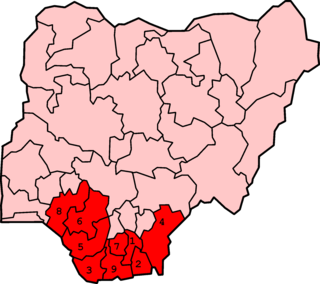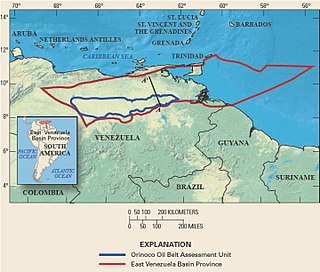
The Niger Delta Basin, also referred to as the Niger Delta province, is an extensional rift basin located in the Niger Delta and the Gulf of Guinea on the passive continental margin near the western coast of Nigeria with suspected or proven access to Cameroon, Equatorial Guinea and São Tomé and Príncipe. This basin is very complex, and it carries high economic value as it contains a very productive petroleum system. The Niger delta basin is one of the largest subaerial basins in Africa. It has a subaerial area of about 75,000 km2, a total area of 300,000 km2, and a sediment fill of 500,000 km3. The sediment fill has a depth between 9–12 km. It is composed of several different geologic formations that indicate how this basin could have formed, as well as the regional and large scale tectonics of the area. The Niger Delta Basin is an extensional basin surrounded by many other basins in the area that all formed from similar processes. The Niger Delta Basin lies in the south westernmost part of a larger tectonic structure, the Benue Trough. The other side of the basin is bounded by the Cameroon Volcanic Line and the transform passive continental margin.

The Niger Delta is the delta of the Niger River sitting directly on the Gulf of Guinea on the Atlantic Ocean in Nigeria. It is located within nine coastal southern Nigerian states, which include: all six states from the South South geopolitical zone, one state (Ondo) from South West geopolitical zone and two states from South East geopolitical zone.

The Orinoco Belt is a territory in the southern strip of the eastern Orinoco River Basin in Venezuela which overlies the world's largest deposits of petroleum. Its local Spanish name is Faja Petrolífera del Orinoco.

After Angola, Nigeria is Africa's second-largest producer of gas and oil.[1] The Niger Delta basin produces two different grades of crude oil: light, which has an API gravity of about 36, and heavy, which has an API gravity of 20–25. Both varieties have less sulfur and are paraffinic.Since 1960, the petroleum industry has been a major source of income and revenue for Nigeria's budget and economy.[3] According to data as of February 2021, the oil industry in Nigeria accounts for roughly 9% of the country's GDP.[4] Nigeria is a significant supplier of petroleum products and crude oil to the US market. Nigeria shipped more than a million barrels to the US every day in 2010, which amounted to

Shell Nigeria is the common name for Shell plc's Nigerian operations carried out through four subsidiaries—primarily Shell Petroleum Development Company of Nigeria Limited (SPDC). Royal Dutch Shell's joint ventures account for more than 21% of Nigeria's total petroleum production.

Petroleum production in Canada is a major industry which is important to the overall economy of North America. Canada has the third largest oil reserves in the world and is the world's fourth largest oil producer and fourth largest oil exporter. In 2019 it produced an average of 750,000 cubic metres per day (4.7 Mbbl/d) of crude oil and equivalent. Of that amount, 64% was upgraded from unconventional oil sands, and the remainder light crude oil, heavy crude oil and natural-gas condensate. Most of the Canadian petroleum production is exported, approximately 600,000 cubic metres per day (3.8 Mbbl/d) in 2019, with 98% of the exports going to the United States. Canada is by far the largest single source of oil imports to the United States, providing 43% of US crude oil imports in 2015.

The current conflict in the Niger Delta first arose in the early 1990s over tensions between foreign oil corporations and a number of the Niger Delta's minority ethnic groups who feel they are being exploited, particularly the Ogoni and the Ijaw. Ethnic and political unrest continued throughout the 1990s despite the return to democracy and the election of the Obasanjo government in 1999. Struggle for oil wealth and environmental harm over its impacts has fueled violence between ethnic groups, causing the militarization of nearly the entire region by ethnic militia groups, Nigerian military and police forces, notably the Nigerian Mobile Police. The violence has contributed to Nigeria's ongoing energy supply crisis by discouraging foreign investment in new power generation plants in the region.
Environmental issues in the Niger Delta are caused by its petroleum industry. The delta covers 20,000 km2 (7,700 sq mi) within wetlands of 70,000 km2 (27,000 sq mi) formed primarily by sediment deposition. Home to 20 million people and 40 different ethnic groups, this floodplain makes up 7.5% of Nigeria's total land mass. It is the largest wetland and maintains the third-largest drainage basin in Africa. The Delta's environment can be broken down into four ecological zones: coastal barrier islands, mangrove swamp forests, freshwater swamps, and lowland rainforests. Fishing and farming are the main sources of livelihoods for majority of her residents.
The Bonga Field is an oilfield in Nigeria. It was located in License block OPL 212 off the Nigerian coast, which was renamed OML 118 in February 2000. The field covers approximately 60 km2 in an average water depth of 1,000 metres (3,300 ft). The field was discovered in 1996, with government approval for its development given in 2002. The field began first production in November 2005. The field is worked via an FPSO vessel. The field produces both petroleum and natural gas; the petroleum is offloaded to tankers while the gas is piped back to Nigeria where it is exported via an LNG plant. The field contains approximately 6,000 mm barrels of oil.
ExxonMobil has offshore oil production in Nigeria, and is the country's second largest crude oil producer. Mobil Producing Nigeria (MPN) began shallow water operations in 1955, and owns over 90 platforms and 300 producing wells covering 3,200 square kilometres.
This page summarizes projects that brought more than 20,000 barrels per day (3,200 m3/d) of new liquid fuel capacity to market with the first production of fuel beginning in 2008. This is part of the Wikipedia summary of Oil Megaprojects.

Sweet Crude is a documentary film about Nigeria's oil-rich Niger Delta directed by Sandy Cioffi. The film premiered in April 2009 at the Full Frame Documentary Film Festival and has since screened at 30 film festivals around the world and has won numerous awards.

Krishna Godavari Basin is a peri-cratonic passive margin basin in India. It is spread across more than 50,000 square kilometres in the Krishna River and Godavari River basins in Andhra Pradesh. The site is known for the D-6 block where Reliance Industries discovered the biggest natural gas reserves in India in 2003.
Oloibiri Oilfield is an onshore oilfield located in Oloibiri in Ogbia LGA of Bayelsa State, Nigeria, and was the first to be discovered in that country. It is located about 45 miles (72 km) east of Port Harcourt in the Niger Delta. Oloibiri field is about 13.75 square kilometres (5.31 sq mi) and lies in a swamp within OML 29

In 2018, Nigeria's primary energy consumption was about 155 Mtoe. Most of the energy comes from traditional biomass and waste, which accounted for 73.5% of total primary consumption in 2018. The rest is from fossil fuels (26.4%) and hydropower.
Seplat Energy (Seplat) is a Nigerian independent oil and gas company listed on both the London and Nigerian Stock Exchanges with assets in the Niger Delta.
The Niger Delta Avengers (NDA) is a militant group in the Niger Delta region of Nigeria. The group publicly announced their existence in March 2016.

Chevron Nigeria Limited is a subsidiary of Chevron Corporation and it is one of the largest oil producers in Nigeria. It was previously operating in Nigeria under the business name of Gulf Oil Company until merger activities changed its name to Chevron Nigeria. After another merger by the parent company with Texaco, the Nigerian oil and gas assets of Texaco Overseas Petroleum Company of Nigeria were merged into Chevron.
Oil theft in Nigeria is considered to be the illegal appropriation of crude or refined oil products from the pipelines of multinational oil companies. Oil theft in Nigeria is facilitated by the pragmatic co-operation between security forces, militia organizations, the local population, and oil company employees who use a variety of methods to steal oil from the multinational oil corporations that are stationed within the country. Currently, Exxon Mobil, Chevron, Equinor, Shell, and Agip are the five largest multinational oil companies present in Nigeria. Due to the lack of federal oversight and a large network of corruption, oil theft is primarily cellular rather than hierarchical and requires frequent collaboration between a variety of random players depending on the level of oil theft being committed. Each group maintains a specific role in the oil theft trade in Nigeria. These key players use methods such as hot-tapping and cold-tapping to perform oil bunkering and steal thousands of barrels of oil per day from established oil pipelines. In addition to stealing oil from the pipelines, oil theft can also occur during the transportation of the crude oil product to the oil shipping terminals for export.








